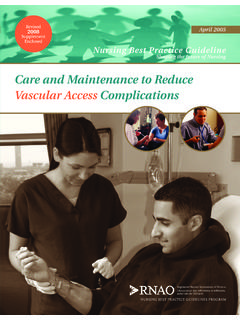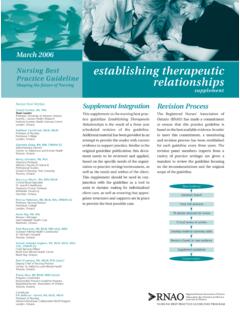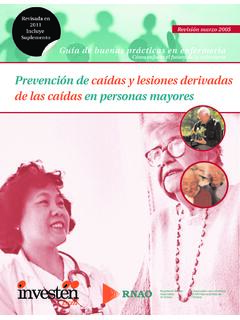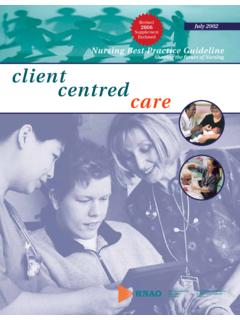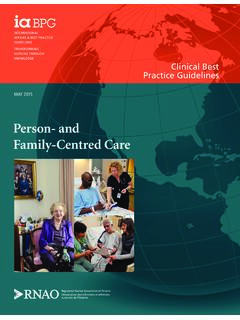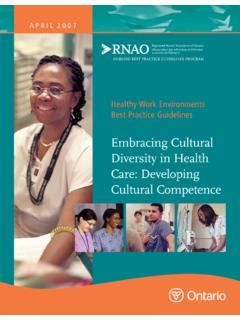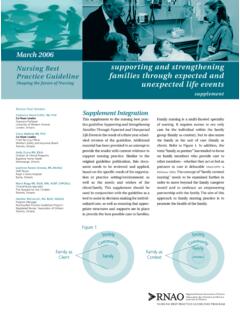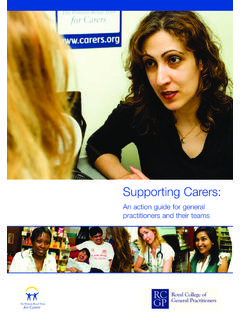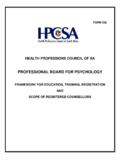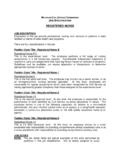Transcription of Managing and Mitigating Conflict in Health-care …
1 Healthy Work Environment Best Practice Guidelines SEPTEMBER 2012. Managing and Mitigating Conflict in Health-care Teams BEST PRACTICE GUIDELINES w w w. r n a o . c a 1. Managing and Mitigating Conflict in Health-care Teams Disclaimer These guidelines are not binding for nurses or the organizations that employ them. The use of these guidelines should be flexible based on individual needs and local circumstances. They neither constitute a liability nor discharge from liability. While every effort has been made to ensure the accuracy of the contents at the time of publication, neither the authors nor the registered Nurses' Association of Ontario (RNAO) give any guarantee as to the accuracy of the information contained in them nor accept any liability, with respect to loss, damage, injury or expense arising from any such errors or omission in the contents of this work.
2 Copyright With the exception of those portions of this document for which a specific prohibition or limitation against copying ap- pears, the balance of this document may be produced, reproduced and published in its entirety, without modification, in any form, including in electronic form, for educational or non-commercial purposes. Should any adaptation of the mate- rial be required for any reason, written permission from the registered Nurses' Association of Ontario must be obtained. The appropriate credit or citation must appear on all copied materials, as follows: registered Nurses' Association of Ontario (2012). Managing and Mitigating Conflict in Health-care Teams. Toronto, Canada: registered Nurses' Association of Ontario. This program is funded by the Ministry of health and Long-Term care . Contact Information registered Nurses' Association of Ontario Healthy Work Environments Best Practice Guidelines Project 158 Pearl Street, Toronto, Ontario M5H 1L3.
3 Website: 2 R E G I S T E R E D N U R S E S ' A S S O C I AT I O N O F O N TA R I O. Managing and Mitigating Conflict in Health-care Teams Greetings from Doris Grinspun, Chief Executive Officer (CEO) registered Nurses' Association of Ontario It is with great pleasure that the registered Nurses' Association of Ontario (RNAO) releases the Managing and Mitigating Conflict Guideline in Health-care Teams Healthy Work Environments Best Practice Guideline. This is one of a series of Best Practice Guidelines (BPG) on Healthy Work Environments (HWE) developed by the nursing community to date. The aim of these guidelines is to provide the best available evidence to support the creation of healthy and thriv- ing work environments. These guidelines, when applied, will serve to support the excellence in service that nurses are committed to delivering in their day-to- day practice.
4 RNAO is delighted to be able to provide this key resource to you. We offer our endless gratitude to the many individuals and institutions that are making our vision for HWE BPGs a reality: the Government of Ontario for recognizing RNAO's ability to lead the program and providing generous fund- ing; Irmajean Bajnok, Director, RNAO International Affairs and Best Practice Guidelines (IABPG) Centre, for her expertise and leadership in advancing the production of HWE BPGs; all HWE BPG team Leaders, and for this BPG in particular Joan Almost, Derek Puddester, Angela Wolff and Loretta McCormick for their superb stewardship, commitment and, above all, exquisite expertise. Thank you also to Program Manager Althea Stewart-Pyne who provided leader- ship to the process and worked intensely to see that this BPG move from con- cept to reality. A special thanks to the BPG panel we respect and value your expertise and volunteer work.
5 To all, we could not have done this without you! The nursing community, with its commitment to and passion about, excellence in nursing care and healthy work environments, has provided the knowledge and countless hours essential to the creation, evaluation and revision of each guideline. Employers have responded enthusiastically by nominating best practice champions, implementing and evaluating the guidelines, and working toward a culture of evidence-based practice and management decision-making. Creating healthy work environments is both an individual and collective responsibility. Successful uptake of these guidelines requires a concerted effort by governments, administrators, clinical staff and others, partnering together to create evidence-based practice cultures. We ask that you share this guideline with members of your team . There is much we can learn from one another.
6 Together, we can ensure that nurses and other Health-care workers contribute to building healthy work environments. This is central to ensuring quality patient care . Let's make Health-care providers and the people they serve the real winners of this important effort! Doris Grinspun, RN, MSN, PhD, LLD(Hon), Chief Executive Officer (CEO). registered Nurses Association of Ontario BEST PRACTICE GUIDELINES w w w. r n a o . c a 1. Managing and Mitigating Conflict in Health-care Teams Table of Contents How to use this Purpose and Guiding Principles and Summary of BACKGROUND. Sources and Types of Evidence ..15. Development Panel Stakeholder Background to the Healthy Work Environments Best Practice Guidelines Organizing Framework for the Healthy Work Environments Best Practice Guidelines Background Context of the Guideline ..26. Recommendations and Discussion of Organization Individual/ team R E C O M M E N D AT I O N S.
7 External/System Government Research Accreditation Education Nursing Professional/Regulatory Evaluation and Monitoring of the Guideline ..53. Process for Reviewing and Updating the Healthy Work Environments Best Practice 2 R E G I S T E R E D N U R S E S ' A S S O C I AT I O N O F O N TA R I O. Managing and Mitigating Conflict in Health-care Teams REFERENCES. Appendix A: Glossary of Appendix B: Guideline Development APPENDICES. Appendix C: Process for Systematic Review of the Literature ..75. Appendix D: Examples of Conflict Management ..78. Appendix E: Resources for Promoting Appendix F: Additional Resources ..85. Throughout this document words marked with the symbol G can be found in the Glossary BEST PRACTICE GUIDELINES w w w. r n a o . c a 3. Managing and Mitigating Conflict in Health-care Teams How To Use this Document BACKGROUND. This Healthy Work Environments Best Practice Guideline is an evidence-based document that focuses on Managing and Mitigating conflictG in Health-care teamsG.
8 The guideline contains much valuable information but is not intended to be read and applied at one time. We recommend that you review and reflect on the document and implement the guidelines as appropriate for your organization at a particu- lar time. The following approach may be helpful. 1. Study the Healthy Work Environments Organizing Framework: The Managing and Mitigating Conflict in Health-care Teams is built upon a Healthy Work Environments organizing framework that was created to allow users to un- derstand the relationships between and among the key factors. Understanding the framework is critical to using the guideline effectively. We suggest that you spend time reading and reflecting upon the framework as a first step. 2. Identify an area of focus: Once you have studied the framework, we suggest that you identify an area of focus for yourself, your situation or your organization.
9 Select an area that you believe needs attention to provide an environment that understands Conflict and when intervention may be necessary. 3. Read the recommendations and the summary of research for your area of focus: For each major element of the model, a number of evidence-based recommendations are offered. The recommendations are statements of what nurses, Health-care teams, organizations and systems do, or how they behave, in order to provide a supportive work environment for nurses. The literature supporting those recommendations is briefly summarized, and we believe that you will find it helpful to read this summary to understand the rationale for the recommendations. 4. Focus on the recommendations or desired behaviours that seem most appropriated for you and your current situation: The recommendations contained in this document are not meant to be applied as rules, but rather as tools to assist individuals, organizations and systems to make decisions that work towards providing a supportive environ- ment for nurses and Health-care teams, recognizing everyone's unique culture, climate and situational challenges.
10 In some cases there is a lot of information to consider. You will want to further explore and identify those behaviours that need to be analyzed and/or strengthened in your situation. 5. Make a tentative plan: Having selected a small number of recommendations and behaviours for attention, consider strategies for successful implementation. Make a tentative plan for what you might actually do to begin to address your area of focus. If you need more information, you may wish to refer to some of the references cited, or to look at some of the ad- ditional resources identified in Appendix F. 6. Discuss the plan with others: Take time to get input into your plan from people who may be affected or whose engage- ment will be critical to success, and from trusted advisors, who will give you honest and helpful feedback on the appropriate- ness of your ideas.
